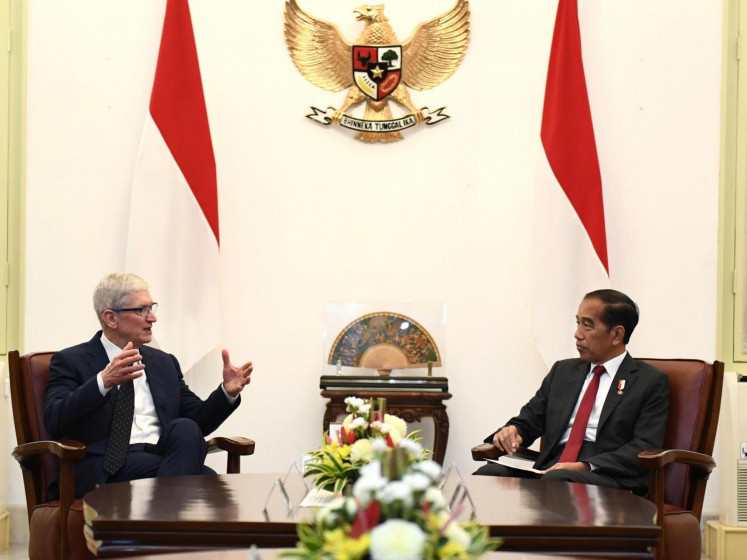'Wayang wahyu': Christmas Javanese style
âChristian Wayang â: The character of Prophet Elijah meets a snake sent by King Ahab in a scene from Hanacaraka Nabi Elia (Prophet Elijahâs story) in a wayang wahyu (biblical wayang) show at Balai Sudjatmoko hall in Surakarta, Central Java, on Dec
Change Size

'Christian Wayang ': The character of Prophet Elijah meets a snake sent by King Ahab in a scene from Hanacaraka Nabi Elia (Prophet Elijah's story) in a wayang wahyu (biblical wayang) show at Balai Sudjatmoko hall in Surakarta, Central Java, on Dec. 14. JP/Ganug Nugroho Adi
Puppet master Ki Blacius Subono endlessly maneuvered the wayang kulit (leather puppets) in his hands while the sound of gamelan intensified then slowed.
The screen was then suddenly deserted, leaving two gunungan (symbolic mountains) moving, before they finally came to a standstill. Several pesinden (female singers) sung a serene song, 'Dandanggula'.
It was a scene from Hanacaraka Nabi Elia (Prophet Elijah's story) in a wayang wahyu (biblical wayang) show at Balai Sudjatmoko hall in Solo, Central Java, on Dec. 14.
This wayang genre is like most shadow puppet plays, but its episodes are based on the Bible rather than the Hindu epics of Ramayana and Mahabharata.
Some other stories adapted for wayang wahyu are Maria (Mary), Pembebasan Israel (Israel Liberation), Kisah Adam-Hawa (The Adam-Eve story) and Yusup Juru Mimpi (Joseph King of Dreams). The other difference is that the main wayang characters adopt biblical figures like Adam, Eve, Elijah, John, Jesus, Joseph and Mary.
The performance was organized by Solo's Pangudi Luhur Foundation to welcome Christmas. In the way the nine Islamic saints in Java once spread Islamic teachings, Christians have also utilized wayang to convey messages of compassion and the word of God.
'Shadow puppet shows as part of local culture serve as our medium for passing on the Kingdom of God in the perspective of the Catholic faith. Wayang should not only be entertainment but also a guide,' said Frans Sugi from the Bishopric of Semarang, Central Java, before the performance.

Hanacara Nabi Elia is about the struggle of the Prophet Elijah to uphold true Christian teachings, appealing for the worship of God Jehovah. The story began with the appearance of King Ahab and his greedy consort Jezebel.
The king was cruel and arbitrary because he felt he was protected by God Baal. The entire population of Israel was ordered to worship God Baal to make his kingdom perpetually prosperous. King Ahab didn't hesitate to kill his defiant people.
Elijah came with tidings from God Jehovah that Israel would be destroyed by a long drought because the people of Israel worshipped God Baal. The furious king then commanded his troops to capture Elijah in order to kill him.
Bono, as Blacius Subono is commonly called, beautifully manipulated the leather puppets, particularly in the scene of the battle between the troops of Ahab and Jehovah. The dalang (puppet master), who is better known as a gamelan musician, was so adept that he managed to display puppet soldiers doing somersaults.

Like in classical wayang plays with goro-goro, a halftime comedic intermezzo, wayang wahyu also has amusing moments, with figures such as Aman and Amin. Bono smartly presented a parody of actual events, such as corruption cases, political tricks, labor demonstrations and student brawls.
With his deep and loud voice, Bono was trying to warn greedy and corrupt leaders against amassing wealth. 'You're all wong gemblung [lunatics]. What's the use if amassing such huge fortunes while you take nothing to your graves? You have people's trust but you're only enriching yourselves.'
Interestingly, Bono avoided literal biblical quotations in his narrations. On the other hand, he made free
interpretations while combining them with the imaginations of the characters he staged.
When presenting Elijah, endowed by God with the miracle of resistance to fire, for instance, Bono created a light expression that could be more easily accepted by a present-day audience.
'Hey, have I gone mad? Why can't the blaze consume my body? The fire on earth no longer scorches me, but just makes me feel fresh,' said Bono, amusing the audience.
According to Bono, wayang wahyu performances constitute a process of transformation of dogmatic values through the medium of wayang as a form of local wisdom.
By this means, followers of Christianity can conduct introspection, spiritual enrichment and acquire biblical insights.
'Those embracing Catholicism are likely to discover a religious phenomenon as part of their spiritual journey in this life,' the puppet master said.
Wayang wahyu in its current form originated from the creativity of Timoteus L. Wignyosoebroto in 1960, when he was inspired by a shadow puppet show that told the story of David receiving a divine revelation, fully adopted from the Old Testament.
'In its early stages, wayang wahyu used the same characters as those of classical wayang plays such as Krishna and Arjuna. In the further development of the art, characters in the Bible were adopted,' explained Bono.
As indicated by Bono, wayang wahyu lies between Eastern and Western aesthetic values, traditional art and church influence, and between artists' creativity and doctrinal obedience.
The scenes in wayang wahyu, with their Christian philosophy, are mostly expressed in a Javanese traditional style. 'The two values [Christian philosophy and Javanese manifestation] become an energy that fuels wayang wahyu,' he noted.
However, the classical art lecturer from the Indonesian Arts Institute (ISI) in Solo, stressed the difference between wayang wahyu and church sermons, as biblical wayang shows were beyond the church domain. Apart from Catholics, the general public can also enjoy these performances.
Wayang wahyu was not designed to create a new paradigm of acculturation either, but rather a medium for adapting the Catholic faith to the culture and place where it was professed. Nor was it intended to incorporate Christianity into Javanese cosmology, but was only meant as an alternative way of reading the religion in the language of the Javanese.
'The core point is that wayang wahyu is not for Christianization. This medium is solely meant to make biblical performances produce a new image that the Catholic faith can get closer to Javanese culture,' assured Bono.
In the view of Sugi, the wayang medium is needed because various biblical messages can easily reach their target through entertainment. By the same means, messages of virtue can also be communicated to non-Christians.
Sugi cited the main Christmas message in Hanaraca Nabi Elia ' compassion ' had diverse concrete forms.
'Although a Christmas message, its moral values don't belong to the church alone, but also to other religions and beliefs. Compassion will make life more peaceful and imbued with tolerance, whatever religion is followed.'









